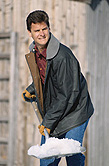|
1/17/2009's Health News
Last Seven Days' Health News 
|
"It takes only minutes for exposed skin to become frostbitten if the temperature falls below 20 degrees Fahrenheit and the wind is blowing at 20 miles per hour or more," Dr. Taizoon Baxamusa, spokesman for the American Academy of Orthopaedic Surgeons, said in a news release issued by the academy. "Your hands, fingers, feet, toes and ears are especially susceptible, so you need to take special care protecting them."
Frostbite can cause permanent damage, causing long-term chronic pain and sensitivity to cold or numbness. In extreme cases, amputation may be necessary.
The academy offers these tips and precautions to avoid frostbite:
- Dress appropriately, wearing light, loose layers with a top shell of water-repellent (not waterproof) fabric. Take special care to protect your head, hands and feet. Watch for exposed skin, such as the neck or where your glove meets the sleeve.
- Avoid alcohol, caffeine and nicotine. They leave the skin more prone to thermal injury.
- If you get wet, get indoors immediately and change clothes.
- If any part of your feels numb, get inside immediately. Pay special attention to your toes, fingers and ears.
If you suspect you have frostbite, seek medical attention immediately. Frostbite areas may look white, gray or waxy and feel numb, hard or frozen.
If you can't get help right away, seek a warm area, rest, and elevate the injured area. Warm the area or use wet heat (never hot bath or dry heat, which can cause scalding or burning) for at least 30 to 45 minutes until sensation returns. Do not rub injured areas and cover any blisters with a sterile or clean cloth.
More information
The U.S. Centers for Disease Control and Prevention has more about cold-weather safety.
Attribution: -- Kevin McKeeverSOURCE: American Academy of Orthopaedic Surgeons, news release, Jan. 13, 2009
Copyright © 2009 ScoutNews, LLC
 . All rights reserved.
. All rights reserved.HealthDayNews articles are derived from various sources and do not reflect federal policy.
omhrc.gov does not endorse opinions, products, or services that may appear in news stories.


